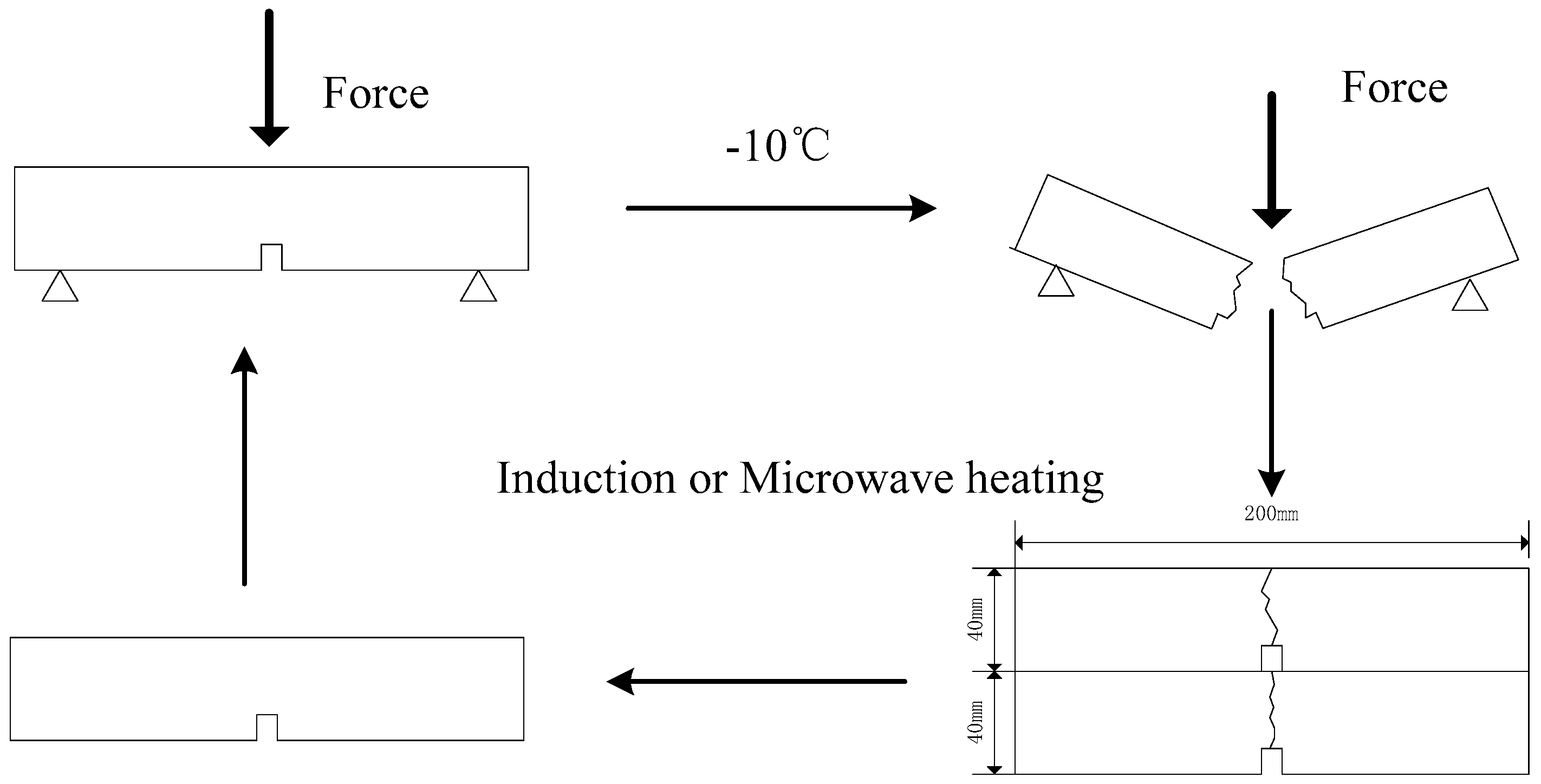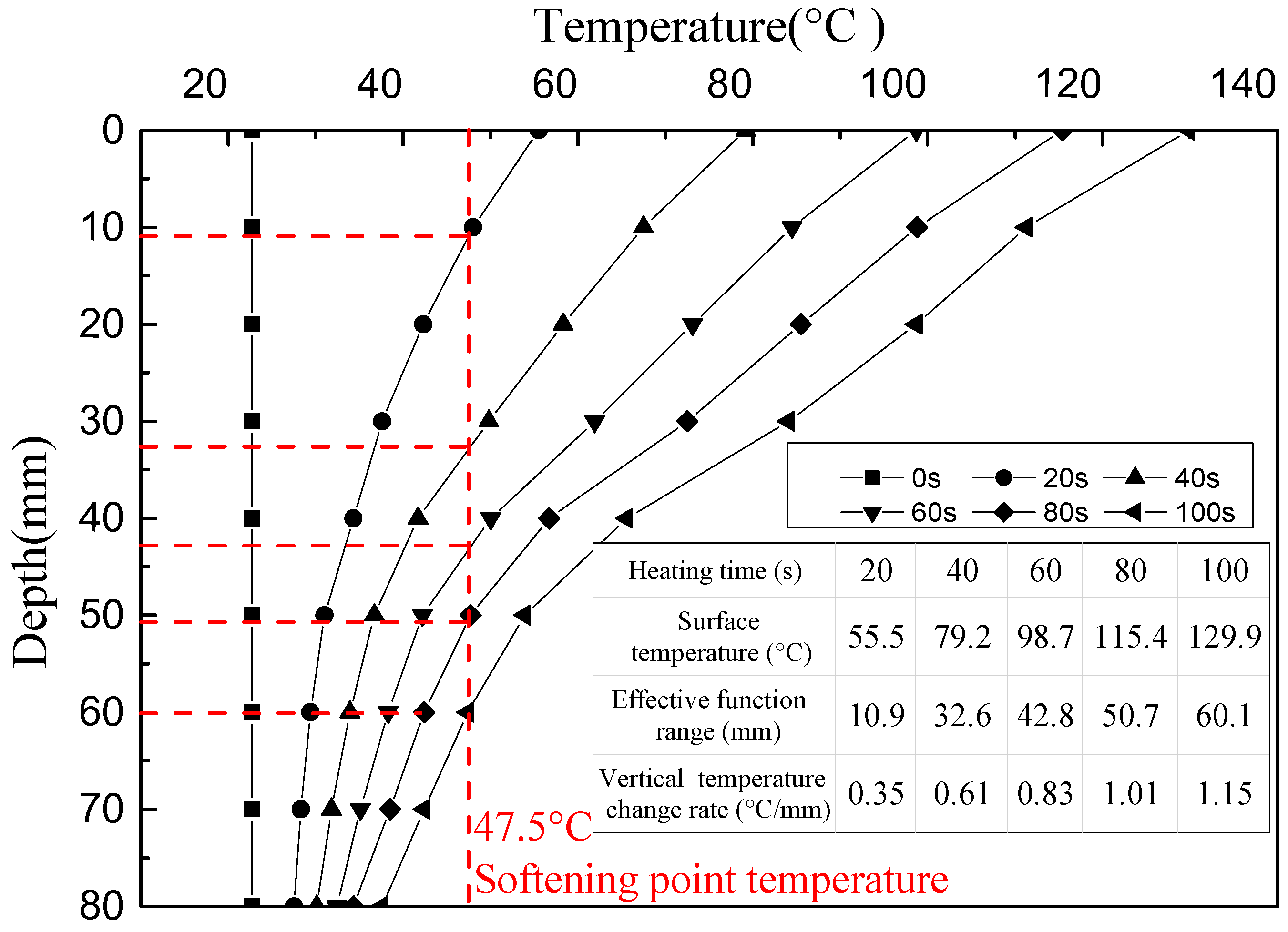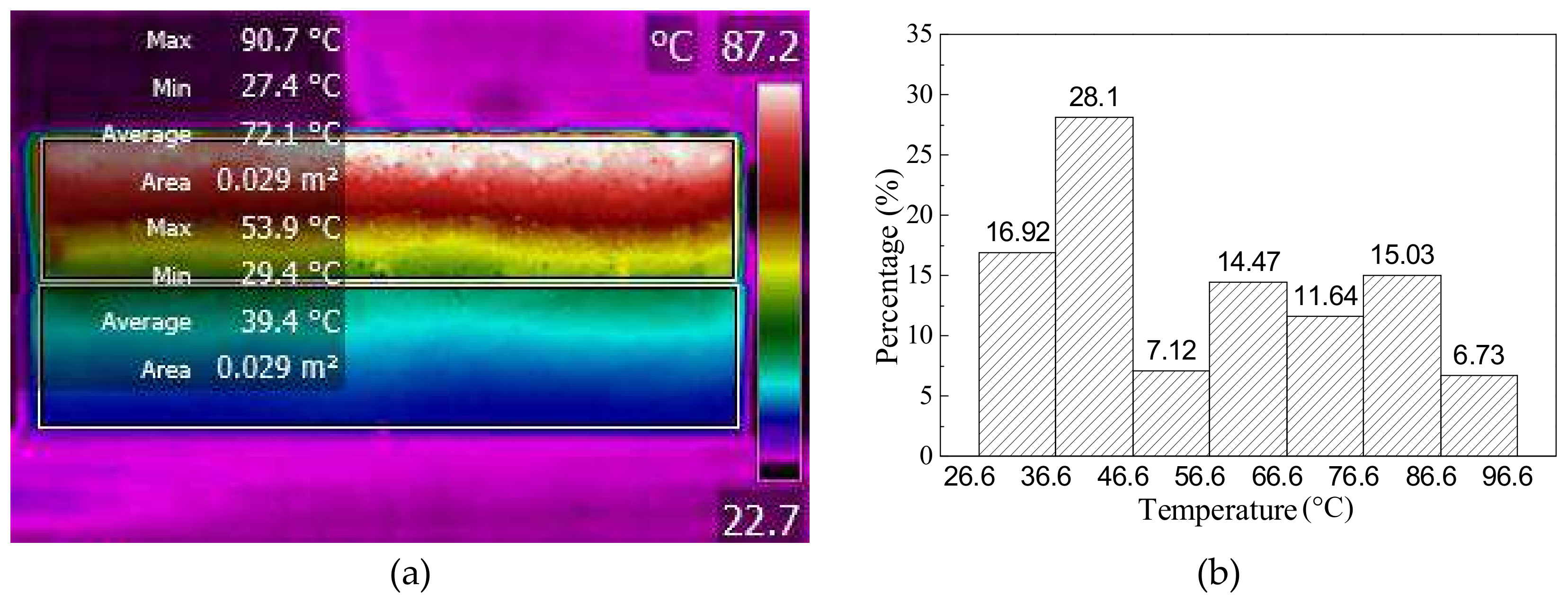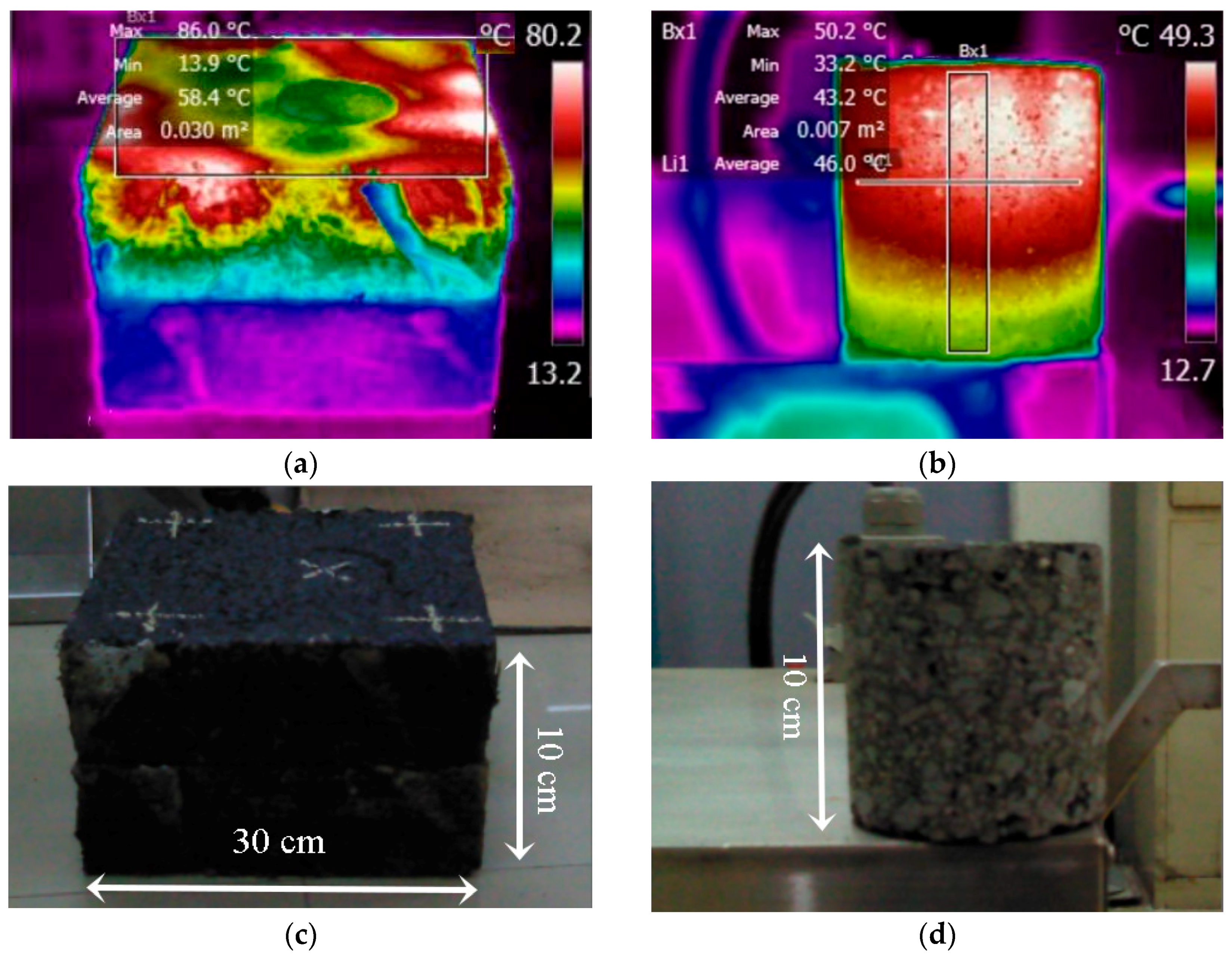Heating Characteristics and Induced Healing Efficiencies of Asphalt Mixture via Induction and Microwave Heating
Abstract
:1. Introduction
2. Materials and Experiments
2.1. Materials
2.2. Sample Preparation
2.3. Induction and Microwave Heating
2.4. Fracture and Healing Test
3. Results and Discussion
3.1. Heating Characteristics of Asphalt Mixture with Induction Heating
3.2. Healing Performance of an Asphalt Mixture at Different Induction Heating Temperature Gradients
3.3. Heating Characteristics of Asphalt Mixture with Microwave Heating
3.4. Induced Healing Performance of Asphalt Mixture with Microwave Heating
4. Conclusions
- There is a strong temperature gradient through the thickness of asphalt sample heated with induction heating. The temperature difference between the surface and bottom of the sample increased with the heating time. An effective heating depth exists for each induction heating time, and the maximum effective heating depth of asphalt mixture with induction heating is around 48 mm, based on the allowable maximum surface temperature. It is inadvisable to increase the effective heating depth of the sample by extending the induction heating time, which will result in excess expansion deformation of the mixture.
- Gradient healing phenomenon exists with the sample heated via induction heating, and is mainly related to temperature gradient distribution. The upper part of the sample healed much better than the lower part.
- Microwave heating is relatively uniform in a longitudinal distribution, and the heating uniformity is independent of heating time.
- Microwave heating causes more uniform crack healing in an asphalt mixture. The weight of the sample has a positive effect on healing at lower temperatures, but a negative effect on healing at excessively high temperatures.
- Under the similar power and same radiation way, induction heating is fast and inhomogeneous in the longitudinal direction, while microwave heating is slow and uniform. The effective heating depth of microwave heating is much higher than that of induction heating.
Author Contributions
Funding
Conflicts of Interest
References
- Norambuena-Contreras, J.; Garcia, Á. Self-healing of asphalt mixture by microwave and induction heating. Mater. Des. 2016, 106, 404–414. [Google Scholar] [CrossRef]
- Liu, Q.; García, Á.; Schlangen, E.; van de Ven, M. Induction healing of asphalt mastic and porous asphalt concrete. Constr. Build. Mater. 2010, 25, 3746–3752. [Google Scholar] [CrossRef]
- Li, R.; Wang, C.; Wang, P.; Pei, J. Preparation of a novel flow improver and its viscosity-reducing effect on bitumen. Fuel 2016, 181, 935–941. [Google Scholar] [CrossRef]
- Qiu, J.; van de Ven, M.F.C.; Wu, S.P.; Yu, J.Y.; Molenaar, A.A.A. Investigating the self healing capability of bituminous binders. Road Mater. Pavement Des. 2009, 10, 81–94. [Google Scholar] [CrossRef]
- García, Á.; Schlangen, E.; van de Ven, M.; Liu, Q. Induction heating of mastic containing conductive fibers and fillers. Constr. Build. Mater. 2009, 23, 3175–3181. [Google Scholar] [CrossRef]
- Gallego, J.; del Val, M.A.; Contreras, V.; Paez, A. Heating asphalt mixtures with microwaves to promote self-healing. Constr. Build. Mater. 2013, 42, 1–4. [Google Scholar] [CrossRef]
- Gómez-Meijide, B.; Ajam, H.; Lastra-González, P.; García, Á. Effect of air voids content on asphalt self-healing via induction and infrared heating. Constr. Build. Mater. 2016, 126, 957–966. [Google Scholar] [CrossRef]
- Wang, Z.; Dai, Q.; Porter, D.; You, Z. Investigation of microwave healing performance of electrically conductive carbon fiber modified asphalt mixture beams. Constr. Build. Mater. 2016, 126, 1012–1019. [Google Scholar] [CrossRef]
- Tan, Y.; Shan, L.; Kim, Y.R.; Underwood, B.S. Healing characteristics of asphalt binder. Constr. Build. Mater. 2012, 27, 570–577. [Google Scholar] [CrossRef]
- Liu, Q.; Wu, S.; Schlangen, E. Induction heating of asphalt mastic for crack control. Constr. Build. Mater. 2013, 41, 345–351. [Google Scholar] [CrossRef]
- García, Á.; Bueno, M.; Norambuena-Contreras, J.; Partl, M. Induction healing of dense asphalt concrete. Constr. Build. Mater. 2013, 49, 1–7. [Google Scholar] [CrossRef]
- Ayar, P.; Moreno-Navarro, F.; Rubio-Gámez, M.C. The healing capability of asphalt pavements: A state of the art review. J. Clean. Prod. 2016, 113, 28–40. [Google Scholar] [CrossRef]
- García, Á.E.; Schlangen, E.; van de Ven, M.; Liu, Q. A simple model to define induction heating in asphalt mastic. Constr. Build. Mater. 2012, 31, 38–46. [Google Scholar] [CrossRef]
- Tang, J.; Liu, Q.; Wu, S.; Ye, Q.; Sun, Y.; Schlangen, E. Investigation of the optimal self-healing temperatures and healing time of asphalt binders. Constr. Build. Mater. 2016, 113, 1029–1033. [Google Scholar] [CrossRef]
- Liu, Q.; Schlangen, E.; van de Ven, M.; van Bochove, G.; van Montfort, J. Evaluation of the induction healing effect of porous asphalt concrete through four point bending fatigue test. Constr. Build. Mater. 2012, 29, 403–409. [Google Scholar] [CrossRef]
- Liu, Q.; Schlangen, E.; van de Ven, M.; García, Á. Healing of porous asphalt concrete via induction heating. Road Mater. Pavement Des. 2010, 11, 527–542. [Google Scholar]
- Wang, Z.; Dai, Q.; Yang, X. Integrated computational-experimental approach for evaluating recovered fracture strength after induction healing of asphalt concrete beam samples. Constr. Build. Mater. 2016, 106, 700–710. [Google Scholar] [CrossRef]
- Dai, Q.; Wang, Z.; Hasan, M.R.M. Investigation of induction healing effects on electrically conductive asphalt mastic and asphalt concrete beams through fracture-healing tests. Constr. Build. Mater. 2013, 49, 729–737. [Google Scholar] [CrossRef]
- Norambuena-Contreras, J.; Serpell, R.; Valdes, V.; Gonzalez, A.; Schlangen, E. Effect of fibres addition on the physical and mechanical properties of asphalt mixtures with crack-healing purposes by microwave radiation. Constr. Build. Mater. 2016, 127, 369–382. [Google Scholar] [CrossRef]
- Pamulapati, Y.; Elseifi, M.; Cooper, S.; Mohammad, L.; Elbagalati, O. Evaluation of self-healing of asphalt concrete through induction heating and metallic fibers. Constr. Build. Mater. 2017, 146, 66–75. [Google Scholar] [CrossRef]
- Collin, R.E. Foundations for Microwave Engineering; Willey: Hoboken, NJ, USA, 2000. [Google Scholar]
- Wang, Z.; Wang, H.; An, D.; Ai, T.; Zhao, P. Laboratory investigation on deicing characteristics of asphalt mixtures using magnetite aggregate as microwave-absorbing materials. Constr. Build. Mater. 2016, 124, 589–597. [Google Scholar] [CrossRef]
- Alohaly, A.; Terrel, R.L. Effect of Microwave Heating on Adhesion and Moisture Damage of Asphalt Mixtures; National Research Council, Transportation Research Board: Washington, DC, USA, 1998. [Google Scholar]
- Sun, Y.; Wu, S.; Liu, Q.; Li, B.; Fang, H.; Ye, Q. The healing properties of asphalt mixtures suffered moisture damage. Constr. Build. Mater. 2016, 127, 418–424. [Google Scholar] [CrossRef]
- Sun, Y.; Liu, Q.; Wu, S.; Shang, F. Microwave heating of steel slag asphalt mixture. Key Eng. Mater. 2014, 599, 193–197. [Google Scholar] [CrossRef]
- Yu, W. Study of the Induction Healing Behaviors of Hot Warm Mix Asphalt. Master’s Thesis, Wuhan University of Technology, Wuhan, China, 2017. [Google Scholar]
- Liu, Q.; Yu, W.; Wu, S.P.; Schlangen, E.; Pan, P. A comparative study of the induction healing behaviors of hot and warm mix asphalt. Constr. Build. Mater. 2017, 144, 663–670. [Google Scholar] [CrossRef]
- Liu, Q.; Schlangen, E.; van de Ven, M. Induction Healing of porous asphalt concrete beams on an elastic foundation. J. Mater. Civil Eng. 2013, 25, 880–885. [Google Scholar] [CrossRef]
- Moreno-Navarro, F.; Ayar, P.; Sol-Sanchez, M.; Rubiogamez, M.C. Exploring the recovery of fatigue damage in bituminous mixtures at macro-crack level: the influence of temperature, time, and external loads. Road Mater. Pavement Des. 2017, 18, 293–303. [Google Scholar] [CrossRef]










| Materials | Properties | Values | Specifications |
|---|---|---|---|
| Steel fiber | Length (mm) | 4.2 | - |
| Equivalent diameter (μm) | 70–130 | - | |
| Gravity (g/cm3) | 7.8 | - | |
| Bitumen | Penetration (25 °C, 100 g, 5 s, 0.1 mm) | 68 | 60–80 |
| Ductility (15 °C, cm) | >100 | 100 | |
| Softening point (°C) | 47.5 | 47 |
| Beams | Surface Temperature | ||
|---|---|---|---|
| 60 °C | 80 °C | 100 °C | |
| Upper beam | 30.8% | 42.8% | 65.7% |
| Lower beam | 0 | 0 | 12.6% |
| Beams | Average Temperature | ||
|---|---|---|---|
| 60 °C | 80 °C | 100 °C | |
| Upper beam | 30.3% | 65.8% | 62.9% |
| Lower beam | 36.2% | 70.9% | 56.9% |
© 2018 by the authors. Licensee MDPI, Basel, Switzerland. This article is an open access article distributed under the terms and conditions of the Creative Commons Attribution (CC BY) license (http://creativecommons.org/licenses/by/4.0/).
Share and Cite
Liu, Q.; Chen, C.; Li, B.; Sun, Y.; Li, H. Heating Characteristics and Induced Healing Efficiencies of Asphalt Mixture via Induction and Microwave Heating. Materials 2018, 11, 913. https://doi.org/10.3390/ma11060913
Liu Q, Chen C, Li B, Sun Y, Li H. Heating Characteristics and Induced Healing Efficiencies of Asphalt Mixture via Induction and Microwave Heating. Materials. 2018; 11(6):913. https://doi.org/10.3390/ma11060913
Chicago/Turabian StyleLiu, Quantao, Cheng Chen, Bin Li, Yihan Sun, and Hechuan Li. 2018. "Heating Characteristics and Induced Healing Efficiencies of Asphalt Mixture via Induction and Microwave Heating" Materials 11, no. 6: 913. https://doi.org/10.3390/ma11060913




